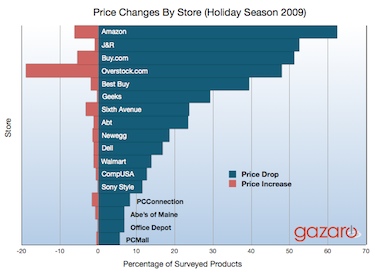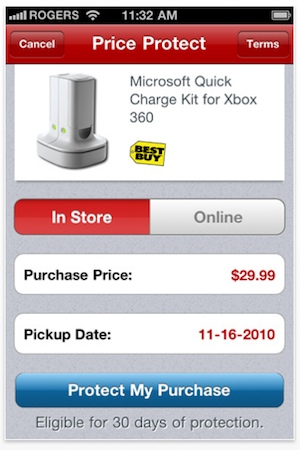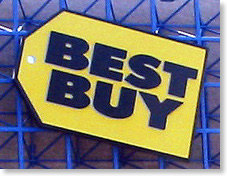(Note: This post first appeared earlier today at Minnov8.com.)
Ever been burned buying a consumer electronics product right before a price reduction and wished you’d have waited? Or, how many times have you been burned and not even known it? Now there’s a solution for both these problems: it’s called Gazaro Protect.  Gazaro is a company that’s been developing a cloud-based, realtime retail pricing platform for several years, using artificial intelligence technology, and is focused initially on consumer electronics. Today, it announced its new pricing protection service, including an iPhone app.
Gazaro is a company that’s been developing a cloud-based, realtime retail pricing platform for several years, using artificial intelligence technology, and is focused initially on consumer electronics. Today, it announced its new pricing protection service, including an iPhone app. 
Maybe you’re thinking you missed out on the best prices on Black Friday or Cyber Monday? Well, get this: Gazaro’s research shows average pricing on featured products at Best Buy during the 2009 Holiday Season was actually lower in the week before December 25 than it was on Black Friday or Cyber Monday (see chart). One in three products dropped in price during the holiday season, with an average price drop of about 15%. Gazaro says its new service helps you take advantage of these price drops. 
How does it work? Using either Gazaro’s web site or its new iPhone app, Gazaro Protect lets consumer electronics shoppers lock in the lowest prices by letting them know when a price drops after they buy, so they can then go get money back. It’s a free web service and mobile app that automatically notifies you of these money-saving price adjustments after you buy. The net advantage, Gazaro says, is you get last-minute holiday prices without having to fight the crowds, or risk a product being sold out if you wait too long.
It’s common for retailers to have policies to refund money to shoppers when products they purchase subsequently drop in price. However, here’s the key: most shoppers don’t collect their price adjustments because of the manual effort to track prices. Of the shoppers surveyed by Gazaro in October 2010, fully 68% did not claim a single price adjustment in the last 12 months. The patent-pending Gazaro Protect service saves shoppers money by automatically notifying them of eligible price adjustments on the products they purchase. In an analysis of 2009 Holiday Season pricing on 120,000 consumer electronics products, including computers, 15% dropped in price by an average of $25.61. And if you doubt just how many products have price drops, check out this following chart showing just how high the percentages are, at several retailers (Best Buy included).
As the company points out, saving money is at the top of most shoppers’ minds in our uncertain economy. Check these stats Gazaro provides: 98% of shoppers surveyed stated they’re willing to claim a price adjustment if they’re notified of it, and 94% are willing to claim price adjustments of anything over $10 in value. 
Gazaro Protect is free for shoppers, and is available by email, website, and as an iPhone app. It is initially featuring only Best Buy products, made available through the BBYOpen platform (an open API), with Gazaro promising “increased functionality for shoppers in the near future.”
Here are three sample use-case scenarios the company provided:
• Mobile: Randy buys a digital camera, and scans the product’s bar code or enters the product’s UPC using the Protect iPhone app. Gazaro registers the product, and automatically tracks the price drops against the store’s price match policy. Randy returns to the store to get his price adjustment when Gazaro notifies him of a price drop. Notification can be by text message or email.
• Email: David buys a printer at the store’s website, and forwards the receipt to protect@gazaro.com. Gazaro automatically parses the receipt information to register the product, and automatically tracks price drops against the store’s price match policy. David calls the store to get his price adjustment when Gazaro notifies him of a price drop.
• Web: Jane buys a flat-screen television in the store or online at the store’s website. She copies and pastes the URL or SKU of the product from the store’s website into the Gazaro Protect website. Gazaro registers the product, and automatically tracks price drops against the store’s price match policy. Jane returns to the store to get her price adjustment when Gazaro notifies her of a price drop.
I spoke with Alexander Rink, Gazaro’s CEO, who said, “Gazaro Protect enables shoppers to buy with peace of mind, locking in low prices by getting money back if prices drop. And it helps retailers by removing shopper doubt at the point of sale, and by creating a positive experience that encourages customer loyalty.” Rink sees his company’s technology as a natural evolution for retail. “It’s a clear win for shoppers — they will increasingly demand this type of service. They want to know they got a good deal. Traditionally, that’s meant looking for a good deal before they buy — which Gazaro also helps shoppers do at our web site — but Protect extends that to after they buy.”
Rink said that smart retailers are increasingly thinking ahead about converting transactions into relationships, “where they take care of the customer before, during, and after the purchase, and make it easy for them to return for their next purchase. Gazaro is the leading the way in thinking of the whole ‘customer lifecycle’ in this way.”
The Gazaro Protect iPhone app is now available in the App Store, and the company plans an Android app “in the near future.”  The Gazaro Protect web site is free to use for all online and offline shoppers, and online shoppers can also get protected by simply forwarding their store email receipts to protect@gazaro.com — as noted above, for purchases made on BestBuy.com.
The Gazaro Protect web site is free to use for all online and offline shoppers, and online shoppers can also get protected by simply forwarding their store email receipts to protect@gazaro.com — as noted above, for purchases made on BestBuy.com.
“Gazaro stands for honest recommendations to help shoppers get the best value for their money,” said Sam Zaid, Founder and CTO in the company’s news announcement. “Gazaro Protect leverages Gazaro’s cloud-based, real-time Retail Pricing Platform to provide a compelling free service for shoppers, and a customer care differentiator for retailers.”
For more about Gazaro, hit the company’s media page and its blog. The company says it “enables shoppers to buy with peace of mind by certifying great deals in real-time, and protecting them after the purchase.” It says it analyzes hundreds of thousands of price points on thousands of computers and electronics products every day, identifying great deals. Its intent is to guide shoppers to smart purchase decisions, and provide retailers with real-time pricing data and analytics.
I requested an interview directly with a manager at BBYopen about Gazaro Protect, but got a curt reply back from the company’s PR department saying it did not want to comment at this time.
Here’s a code for the first 100 people reading this post to get 50% off the price of the “Pro” version of the Gazaro Protect iPhone app: gazaroTSB50. The normal price for an in-app upgrade to Pro is $1.99, so the 50% discount will take that to $0.99. The Pro version unlocks the barcode scanner and gives you unlimited “protects,” while the free version of the app only allows you to protect one product.
(UPDATE 12/3/10: I broke this story when I posted it on Minnov8 yesterday, then several other sites covered it, including CNet, GigaOM, and Lifehacker. Gazaro now tells me they’ve decided to get more generous. They’re allowing our next 250 readers to upgrade to the Pro version of the Gazaro Protect iPhone app for FREE. Just first download the free version of the app, then upgrade in-app using this code: FREEMONEYTSM.)




Recent Comments